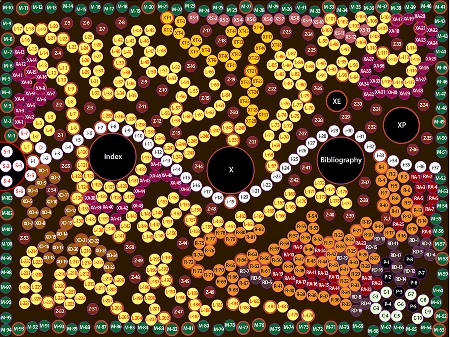 |
Quick start guide
Open the ‘Street Exegesis’ file.
Touch a ‘dot’ to read the text/view the image. Touch it again to close.
This exegesis incorporates all text within an image of ‘dots’, conceptually integrating the thesis’ theory into the thesis as an artistic and aesthetic presentation of relationships within this research. It is presented upon an icon of contemporary technological communication.
The information contained within these dots is presented to allow for visual interpretation of the relationships between the enclosed data, rather than as a proposed technological product.
The dots relate by colour and proximity, coursing and ambling as paths following-on lineally, or spreading and narrowing to suit relationships between the enclosed knowledge and its surrounding environs. The viewer may follow the colour trails that wend across the image, or choose to read by proximity.
The Chapter dots are coloured;
Introduction - White,
Literature Review - Yellow,
Methodology - Green,
Results and Discussion - Orange
Conclusion? - Off White.
There are also a number of Appendix dots;
Ochre, brown and maroon dots of conceptual expansions,
Purple dots of artworks and documentations,
Dark brown dots of journal data examples, and
Musk dots of drawing data examples.
At the left edge of the image is a group of four dots, encompassed within a larger semi-circle. These dots are the opening pages of the exegesis, and incorporate the Title Page, the Abstract, the Academic Declaration, and the Acknowledgements.
The four isolated white dots within proximity of this starting set provide conceptual grounding and terminology definitions.
The three large dots across the centre of the image carry the Index, a non-academic summary, and the Bibliography.
This web based version doesn’t include the iPad gestures.
The images, and some texts open in PDF format, which allow zoom for closer inspection (see R30).
The PDF’s open to a grey screen which requires a sweeping touch to reveal the text. To close, touch the black frame around the image.
Navigation
The layout mainly conforms with the English protocol of reading left to right. So trails of text, such as the white line of Introduction dots, can be read left to right, with related chapter’s text stemming from that ‘‘trunk line’. For example, the Literature Review (yellow) sub-chapters stem from relevant conceptual content in the white Introd uction dots. The Methodology (green) chapter, however, begins at the Title dots and progresses clockwise, framing the study. Again,
relevant text may run from this ‘branch line’. One other exception to the general flow of left to right is sub-section 4 of the Literature Review that stems from a relevant Methodology dot ( m-73), and begins by progressing right to left. For further discussion on the methodology and theories applied in the presentation method see dots m-65 to m-71.
A map of the ‘terrain’ is enclosed to provide dot identification numbers to both enable quick location of a specific paragraph
of text, and assist viewers otherwise lost, to find their way through.
Notes;
Suggested citation method for this exegesis:
Street, Caitlin. 2013, dreamtime uncapitalised, -joining our own dots . para # M52.
Connect to the Thesis
|